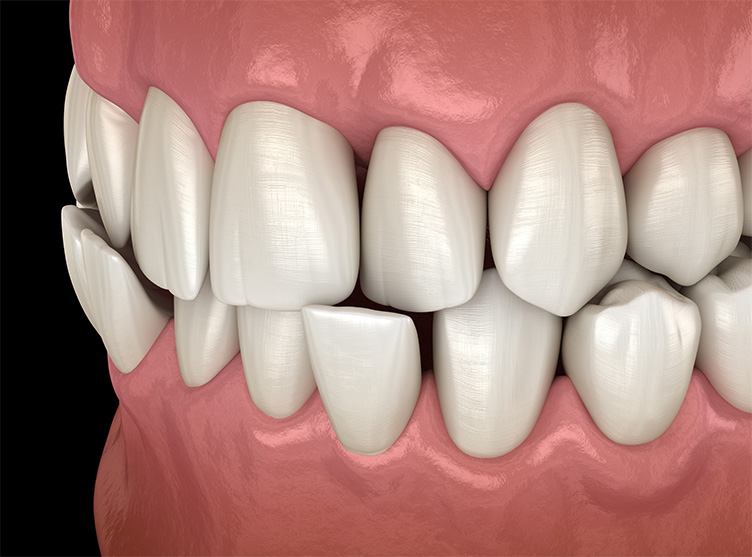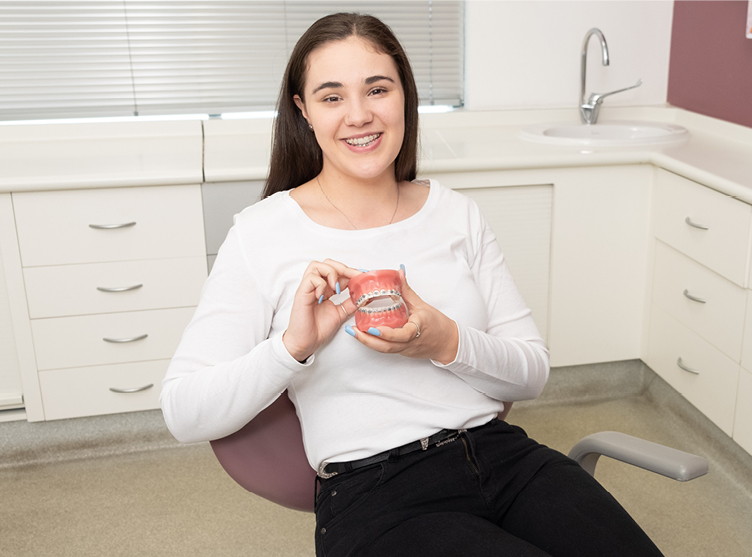
Crossbite is a type of dental misalignment that occurs when the upper and lower teeth do not come together properly. In a crossbite, some of the upper teeth sit inside the lower teeth when the jaw is closed, while others may be positioned outside the lower teeth.
Most crossbites are caused by genetics, meaning it’s something you’re born with. However, crossbites can also affect thumb-sucking habits, pacifier use, or other habits that pressure the teeth. Injury to the face can also cause crossbites.
This article will discuss Crossbite in more detail, including its causes, symptoms, and treatment options.
What is a Crossbite?
Crossbite occurs when a misalignment of upper and lower teeth can appear either in the front or back of the mouth. In an anterior crossbite (front teeth), the upper front teeth bite on the inside of the lower teeth. In a posterior crossbite (back teeth), the lower teeth bite on the inside of the upper back teeth. Crossbites can also involve both the front and back teeth.
Genetics primarily causes a crossbite, meaning it’s something you’re born with. However, crossbites can also affect thumb sucking, pacifier use, or other habits that pressure the teeth. Injury to the face can also cause crossbites.
Let’s discuss further the two types of Crossbite:
Anterior Crossbite

The most common type of Crossbite is an anterior crossbite, which occurs when the upper teeth bite the lower teeth inside. Anterior crossbites can be caused by genetics, thumb sucking, or other habits that pressure the teeth. Injury to the face can also cause an anterior crossbite.
Posterior Crossbite
Posterior crossbites are less common than anterior crossbites. They occur when the lower teeth bite inside the upper teeth. Posterior crossbites can be caused by genetics, thumb sucking, pacifier use, injury to the face, or other habits that pressure the teeth.
What causes Crossbite?
- Pacifier, finger, or thumb sucking that pushes teeth
- Tongue thrust during swallowing
- Missing teeth
- Baby teeth that don’t fall out
- Early baby teeth loss that causes teeth to drift
- A small jaw that can’t fit all your teeth
- Teeth too big to fit well for proper alignment
- Cleft palate
- Cleft lip
- Mouth breathing
Health Risks
Crossbite occurs when there’s a misalignment of the upper and lower teeth, causing the upper teeth to bite inside the lower teeth. Crossbite can lead to dental problems, including tooth wear, gum disease, and even jaw pain when left untreated.
Jaw Pain

Crossbites can cause jaw pain for some reasons.
First, when the teeth are misaligned, it can unnecessarily stress the jaw muscles and joints. It can lead to tension headaches, TMJ disorders, and other types of pain.
Second, Crossbite can also cause gum disease and tooth decay. It is because keeping the teeth clean when they are misaligned is challenging. It can lead to infection and inflammation, which can be pretty painful.
Finally, Crossbite can also cause cosmetic problems. It can lead to feelings of self-consciousness and embarrassment, adding to the stress and tension already present.
Tooth Decay
LIN
Tooth decay is one common problem due to a crossbite. It can cause food and bacteria to get trapped in the spaces between the teeth, which can lead to cavities. It can be challenging to keep misaligned teeth clean.
In addition, gum disease is also more common in people who have a crossbite. The misaligned teeth can stress the gums, making them more susceptible to infection.
Sleep Apnea

There are a few reasons why Crossbite may contribute to sleep apnea.
First, when the teeth are misaligned, it can cause the tongue to sit further back in the mouth. It can block the airway and make it difficult to breathe.
Additionally, Crossbite can cause the soft palate to collapse, which also blocks the airway.
Lastly, Crossbite can lead to teeth grinding, further contributing to sleep apnea.
Frequent Headaches
One of the most common complaints from people with a crossbite is frequent headaches.
There are a few reasons why having a crossbite can lead to headaches. First, when the teeth are misaligned, it can put a lot of strain on the jaw. It can lead to pain in the jaw, which can then radiate to the head and cause a headache.
Additionally, it can cause the bite to be off balance. It can lead to teeth grinding, which can also cause headaches.
Treatments

There are several ways to correct a crossbite. Treatment will depend on the severity of the problem and the patient’s age. In mild cases, simple changes in diet or habits can make a big difference. In severe cases, it requires surgery.
If you have Crossbite, it’s essential to visit an orthodontist to take a closer look and discuss treatment options. You can avoid these health risks and have a healthy, beautiful smile with proper treatment.
Braces

The most common orthodontic treatments to correct a crossbite are metal brackets attached to the teeth with a unique adhesive. The connected brackets in braces are by a wire that runs across them and tightens to move the teeth into their proper positions. In some cases, clear or ceramic braces may be used instead of traditional metal braces.
Invisalign

Invisalign can effectively treat and correct crossbites and improve overall teeth alignment.
Invisalign uses clear and removable aligners to move the teeth into the desired position. This treatment is effective for children and adult teeth and can be an alternative to traditional braces.
Palate Expander

The palate expander is a simple device to widen the small upper jaw. This type of correction is often necessary to treat or correct a crossbite.
The palate expander is inserted into the mouth and gradually expanded over time to correct a crossbite. This process will widen the upper jaw, which will, in turn, allow the teeth to align correctly.
Palate expanders are most often used in children, as their bones are still growing and, therefore, more responsive to expansion. However, adults can also benefit from this type of orthodontic treatment.
FAQs
Overbite vs Crossbite
An overbite is a type of malocclusion or a bad bite. It occurs when the top teeth overlap the bottom teeth too much. Conversely, a crossbite is when the top and bottom teeth don’t line up correctly. Both can cause problems with eating and speaking and may lead to tooth decay and gum disease.
Overbites and crossbites are both types of malocclusion or a bad bite. An overbite occurs when the top overlaps the bottom teeth too much. Conversely, a crossbite is when the top and bottom teeth don’t line up correctly. Both can cause problems with eating and speaking and may lead to tooth decay and gum disease.
Overbites can be caused by various factors, including genetics, thumb sucking, or misaligned teeth. Crossbites can also be caused by genetics, or misaligned teeth cause a crossbite. Treatment for an overbite or Crossbite will depend on the severity of the condition and may include braces, dental appliances, or surgery.
At what age should a crossbite be corrected?

There is no one-size-fits-all answer to this question, as the age at which you should correct a crossbite will vary depending on the individual case. However, it is generally best to treat a crossbite as early as possible, preferably before the child reaches school age. It is because early correcting of a crossbite can help prevent problems such as difficulty chewing or speaking and improve the teeth’ overall alignment. If a crossbite is not corrected early on, it may require more extensive treatment later in life, which can be costly and invasive.
In Summary

In summary, a crossbite is a bad bite that occurs when the top and bottom teeth don’t line up correctly. Crossbites may lead to problems with eating and speaking, tooth decay and gum disease.
Treatment for a crossbite will depend on the severity of the condition and may include braces and dental appliances. A severe crossbite may require surgery. It is generally best to fix a crossbite as early as possible, preferably before the child reaches school age. If a crossbite is not corrected early on, it may require more extensive treatment later in life.
If you think your child may have a crossbite, seek treatment from a dentist or orthodontist as soon as possible to discuss an orthodontic treatment plan. Correcting a crossbite later in life can be costly and invasive.